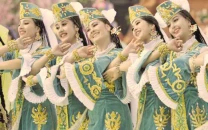Of silhouettes and identities
Osman Yousefzada's work has shot him to international fame, with collections teeming with dramatic drapery.

As I wait to speak to him, he adds the finishing touches to his creation, focusing exclusively on the work at hand. When both client and creator are satisfied, I seize the opportunity to find out more about the designs and the man behind them.
Born in the United Kingdom to Afghan/Pakistani parents, Osman Yousefzada grew up in the fashion industry, beginning in his youth when he worked with his mother in her dressmaking business in Birmingham. Since then, his work has evolved and he has shot to international fame, with his unique collections that are teeming with fused global elements and dramatic drapery.
He brings prominent geocultural influences into all his clothing, but it is his dresses in particular that have caught the eye of the fashionista world. In 2008 Osman launched a limited collection of dresses for Mango, inspired by clothing from all corners of the world, from East Africa to Algeria to Afghanistan. The American edition of Vogue hailed him as the “re-inventor of the Little Black Dress.” Having been part of London Fashion Week for four years running, Yousefzada has enjoyed international acclaim, and dressed numerous celebrities including Dannii Minogue, Thandie Newton and Mischa Barton.
He sees his work as a journey. “It’s an ongoing process of trying to define and create a silhouette, and to create an identity. That has been my main goal, and it’s a goal that lasts a lifetime,” he says. “I want to build up a body of work that involves my perception of beauty and my ideas of construction.”
In May this year, Yousefzada featured in the Victoria & Albert Museum’s ‘Research in Motion’ series, in which selected pieces from each of his collections from the past four-and-a-half years were exhibited. His designs reflect his own fused identity, being of Afghan/Pakistani descent and having had an upbringing in Birmingham: “I think it’s a little bit about where I’m from. It’s always been an element of the outsider looking in, and I think it’s all to do with the realm of identity.”
His design philosophy runs parallel to his life experience, and the thought processes that go into his works represent the natural coming together of these ideas of identity. “It’s clean, it has global references and it’s all very modern. It sort of has an element of timelessness, while still having a clear direction. And it’s all quite dramatic in a way,” he explains.
But, he adds, it is not a straightforward process. He sees it as a “continuous mishmash” of thought processes and research developing from when one’s eye falls on something attractive — in the way a fabric falls, the suggestions of a particular pattern, or the glint of a piece of armour, for example. And this process is not intermittent; “it’s everything all the time,” he says.
In drawing inspiration from world cultures, Yousefzada is careful to avoid the clichés of “ethnic fashion,” where Western fashion sees designs from other parts of the world as “a form of decoration without much substance,” as he explained to the UK’s Independent newspaper. Instead, Osman seeks to draw genuine inspiration from other cultures and to celebrate them in his works, whether in prominent strides or through subtle touches.
Recently, Yousefzada was in Karachi where he was able to get a glimpse of some of the latest works of Pakistani designers. He was pleased to discover young designers being experimental and creating unique works reflective of the personalities behind them.
But more generally, fashion, by definition, is different in Pakistan than it is in the UK, according to Yousefzada: “In Pakistan, it’s very much about going to the darzi and getting something made, so it’s all about the couture while the ready-to-wear market is very limited.” While there is much focus from designers on big-spend items, such as bridal- and party-wear, Osman hopes to see more options for general daywear. He even suggests that he would love to do a shalwar kameez line.
Yousefzada compares the fashion industry in Pakistan to its music industry, suggesting that the two offer immense innovation and creativity, and with time they are developing and evolving.
But there is more to fashion than what you see on the catwalk, as he illustrates: “During my visit to Pakistan, I saw this cleaner walking around with a huge knot around his kameez. Of course he was working, but the silhouette was really beautiful.” It is this immense appreciation of the contours and structure of the body that appears inherent in all of Yousefzada’s designs.
He believes that the silhouette is the key to fashion; the structure that is created to show off the body’s best. “That’s the whole point of designing,” he explains. “To make you look beautiful. It’s basically creating beauty in a technical engineering sort of way.
Published in The Express Tribune, August 29th, 2010.



















COMMENTS
Comments are moderated and generally will be posted if they are on-topic and not abusive.
For more information, please see our Comments FAQ